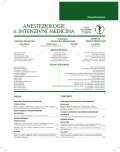Neurotoxicity of anaesthetics on the developing brain
Authors:
V. Mixa
Authors‘ workplace:
Klinika anesteziologie, resuscitace a intenzivní medicíny, 2. lékařská fakulta Univerzity Karlovy a Fakultní nemocnice Motol
Published in:
Anest. intenziv. Med., 28, 2017, č. 5, s. 282-286
Category:
Overview
The neurotoxicity of commonly used anaesthetics for the developing brain of young children is frequently discussed and not fully established nowadays. NMDA and GABA-ergic receptors in the brain, which are affected by most anaesthetics, also control the development of the central nervous system. It can therefore have an impact on the brain neurogenesis with a resulting disorder of the cognitive and behavioural functions. Although the results of recent clinical studies are not available yet, it is recommended to use pharmaceuticals with a lower potential neurotoxicity (sevoflurane, opiates), to combine general and local anaesthesia and to avoid all the influences which may aggravate the possible neurotoxicity (hypoxia, hypercapnia, hypoglycaemia, hypothermia etc.).
Keywords:
neurodevelopment – neurotoxicity – paediatric anesthesia – sevoflurane – isoflurane
Sources
1. Vutskits L, Xie Z. Lasting impact of general anaesthesia on the brain: mechanism and relevance. Nat Rev Neurosci. 2016;18:705–717.
2. Todd MM. Anesthetic neurotoxicity: the collision between laboratory neuroscience and clinical medicine. Anethesiology. 2004;101:227–230.
3. Ikonomidou C, Bosh F, Miksa M, et al. Blocade of NMDA receptors and apoptotic neurodegeneration in the developing brain. Science. 1999;283:70–74.
4. Olsen EA, Brambrink AM. Anesthetic neurotoxicity in the newborn and infant. Curr Opin Anesthesiol. 2013;26:535–542.
5. Johnson SA, Young C, Olney JW. Isoflurane – induced neuroapoptosis in the developing brain of nonhypoglycemic mice. J Neurosurg Anesthesiol. 2008;20:21–28.
6. Jevtovic-Todorovic V, Hartman RE, Izumi Y, et al. Early exposure to common anaesthetic agents causes widespread neurodegeneration in the developing rat brain and persistent learning deficits. J Neurosci. 2003;23:876–882.
7. Liang G, Ward C, Peng J, et al. Isoflurane causes greater neurodegeneration than an equivalent exposure of sevoflurane in the developing brain of neonatal mice. Anestesiology. 2010;112:1325–1334.
8. Istaphanous GK, Howard J, Nan X, et al. Comparison of the neuroapoptotic properties of equipolent anesthetic concentration of desflurane, isoflurane or sevoflurane in neonatal mice. Anestesiology. 2011;114:578–587.
9. Cattano D, Young C, Straiko MM, Olney JW. Subanesthetic doses of propofol induce neuroapoptosis in the infant mouse brain. Anesth Analg. 2008;106:1712–1714.
10. Brambrink AM, Back SA, Ridle A, et al. Isoflurane-induced apoptosis of oligodendrocytes in the neonatal primate brain. Ann Neurol. 2012;72:525–235.
11. Creely C, Dikranian K, Dissen G, et al. Propofol induced apoptosis of neurons and oligodendrocytes in fetal and neonatal rhesus macaque brain. Exp Neurosci. 2012;LBB 10.
12. Mintz CD, Barrett KMS, Smith SC, et al. Anesthetics interfere with axon guidance in developing mouse neocortical neurons in vitro via GABA type A receptor mechanism. Anestesiology. 2013;118:825–833.
13. Boscolo A, Milanovic D, Starr JA, et al. Early exposure to general anesthesia disturbs mitochondrial fussion and fussion in the developing rat brain. Anestesiology. 2013;118:1086–1097.
14. Liu F, Patterson TA, Sadovova N, et al. Ketamine induced neuronal damane and altered N-Methyl-D-Aspartate receptor function in rat primara forebrain culture. Toxicol Sci. 2013; 131:548–557.
15. Ramage TM, Chany FL, Shih J, et al. Distinct long-term neurocognitive outcomes after equipollent sevoflurane or isoflurane anaesthesia in immature rats. Brit J Anaesth. 2013;110(S1):i39-i46.
16. DiMaggio C, Sun LS, Kakavouli A, et al. A retrospective cohort study of the association of anaesthesia and hernia repair surgery with behavioral and developmental disorders in young children. J Neurosurg Anesthesiol. 2009;21:286–291.
17. Wilder RT, Flick RP, Sprung J, et al. Early exposure to anesthesia and learning disabilities in a population based birth cohort. Anestesiology. 2009;110:796–804.
18. Ing C, DiMaggio C, Whitehouse A, et al. Long-term diferences in language and cognitive function after childhood exposure to anaesthesia. Pediatrics. 2012;130:e476–e485.
19. Ing C, DiMagio C, Malacova E, et al. Comparative analysis of outcome measures used in examining neurodevelopmental effects of early childhood anesthesia exposure. Anestesiology. 2014;120:1319–1321.
20. Sun LS, Li G, Miller TL, et al. Association between a single general anesthesia exposure before age 36 month and neurocognitive outcomes in later childhood. JAMA. 2016;315:2312–2320.
21. Davidson AJ, Disma N, de Graaff JC, et al. Neurodevelopmental outcome at 2years of age after general anaesthesia and awake-regional anaesthesia in infancy (GAS): an international multicentre, randomised controled trial. Lancet. 2016;387:239–250.
22. www.fda.gov/Drugs/DrugSafety/ucm532356.htm; FDA Drug Safety Communication.
23. Andropoulos DB, Greene MF. Anesthesia and Developing Brains – Implication of FDA Warning. N Enl J Med org. 2016;1–3.
24. Hansen TG. Use of anaesthetics in young children. Eur J Anaesthesiol. 2017;34: 327–328.
Labels
Anaesthesiology, Resuscitation and Inten Intensive Care MedicineArticle was published in
Anaesthesiology and Intensive Care Medicine

2017 Issue 5
Most read in this issue
- Succesful use of methylene blue in a patient with refractory shock on veno-arterial extracorporeal membrane oxygenation
- Cognitive disorders in perioperative and intensive care
- Neurotoxicity of anaesthetics on the developing brain
- The endothelial glycocalyx and fluid therapy in critical care and perioperative medicine
